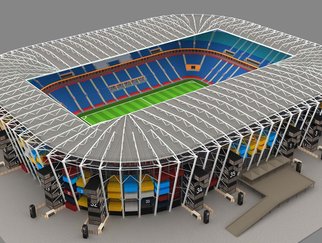
Saudi Arabia is making waves on the global football stage with its ambitious vision to become a football powerhouse by 2034. The nation is not only investing heavily in infrastructure and talent development but is also strategically leveraging its resources to ensure long-term sustainability and global recognition. However, the question remains: Can Saudi Arabia's grand football dream truly be sustainable beyond 2034?
The Vision: A Football Powerhouse by 2034
Saudi Arabia's football ambitions are bold and clear. With the Kingdom's Vision 2030 as a backdrop—a comprehensive plan to diversify the economy and reduce its dependence on oil—football plays a critical role. The nation aims to transform itself into a global sports hub, with football as the crown jewel.
The plan involves significant investments in infrastructure, grassroots development, and international partnerships. The Saudi Arabian Football Federation (SAFF) is spearheading these initiatives, aiming to elevate the Saudi Pro League to be among the top ten leagues globally. The focus is not just on hosting events but building a football culture that can compete on the world stage.

Infrastructure Investments
Saudi Arabia is investing billions in state-of-the-art stadiums and training facilities. The construction of modern stadiums like the Qiddiya Stadium, designed to host major international events, is part of this strategy. These venues are not just for show; they are built to provide world-class facilities for both players and fans, ensuring an immersive football experience.
Moreover, the country is focusing on developing football academies to nurture young talent. These academies aim to provide high-quality training from a young age, following the model of successful European clubs. By developing homegrown talent, Saudi Arabia hopes to create a pipeline of players who can compete at the highest levels.
Talent Development and Grassroots Programs
At the heart of Saudi Arabia's football vision is the commitment to grassroots development. The Saudi Arabian Ministry of Sports, in collaboration with SAFF, is rolling out programs to encourage football at the school level. This initiative aims to increase participation, improve skill levels, and identify potential talents early.
The focus on youth development is crucial. By investing in coaching and facilities at the grassroots level, Saudi Arabia is building a solid foundation for its future football stars. These efforts are complemented by partnerships with established football nations and clubs, providing access to expertise and best practices.
International Partnerships and Global Influence
Saudi Arabia is not working in isolation. It is actively seeking partnerships with international football organizations. These collaborations are essential for knowledge transfer and enhancing the country's footballing standards. For instance, strategic alliances with European clubs offer opportunities for Saudi players to train and play abroad, exposing them to different playing styles and cultures.
Furthermore, Saudi Arabia's investment in international football extends to acquiring stakes in foreign clubs and organizing international tournaments. These moves are designed to increase the country's influence in global football governance, potentially positioning it as a key player in decision-making processes.
Challenges and Criticisms
Despite its ambitious plans, Saudi Arabia faces significant challenges. Sustainability is a major concern. The heavy reliance on financial investment raises questions about the long-term viability of these projects, especially if the expected returns—both financial and social—are not realized.
Critics also point to the country's human rights record, which has been a point of contention in its bid to host international events. While Saudi Arabia has made strides in improving its global image, these issues remain a hurdle in gaining full acceptance in the international football community.
Moreover, the success of Saudi Arabia's football initiatives depends on the ability to integrate these projects into the broader societal framework. This includes ensuring that football contributes to social cohesion and provides opportunities for all segments of the population.
The Path Forward: Sustainability Beyond 2034
For Saudi Arabia's football vision to be sustainable beyond 2034, it must balance ambition with realism. The key lies in creating a self-sustaining football ecosystem. This involves not only continuous investment in infrastructure and talent but also developing a robust domestic league that can generate its own revenue and attract top talent from around the world.
Additionally, fostering a genuine football culture that resonates with the Saudi population is crucial. This means engaging fans and communities, making football accessible to all, and ensuring that the sport becomes a part of the national identity.

Conclusion
Saudi Arabia's football ambitions are nothing short of transformative. By 2034, the nation aims to be a formidable force in global football, hosting major tournaments and producing world-class players. However, the journey is fraught with challenges that require careful navigation.
The Kingdom's success will depend on its ability to create a sustainable model that integrates football into the fabric of society while maintaining international standards. If achieved, Saudi Arabia's football vision could set a precedent for other nations with similar aspirations, demonstrating how strategic investment and long-term planning can redefine a country's sporting landscape.
As the world watches Saudi Arabia's bold journey unfold, one thing is certain: the next decade will be pivotal in shaping the future of football in the Kingdom and its impact on the global stage.